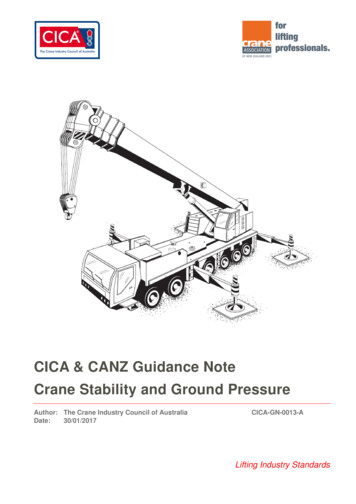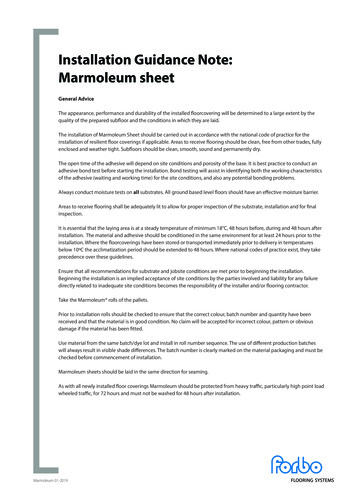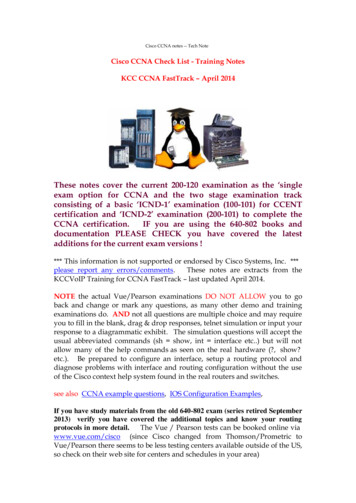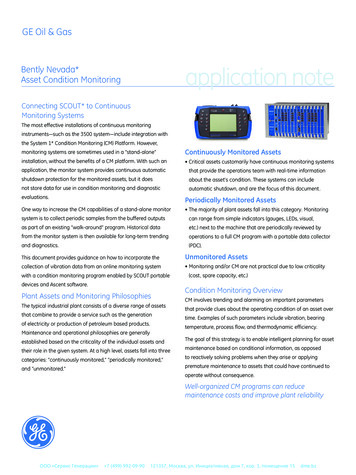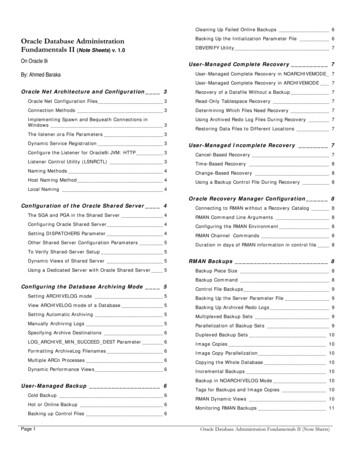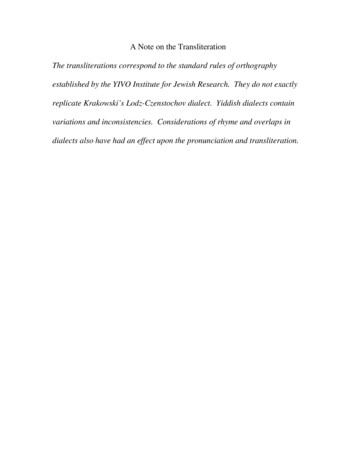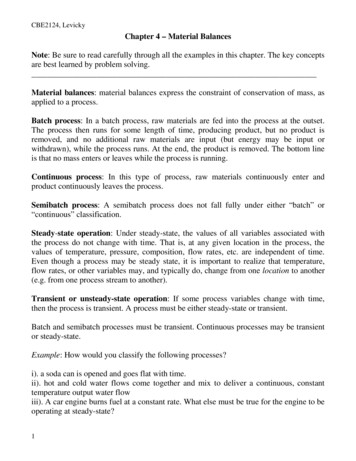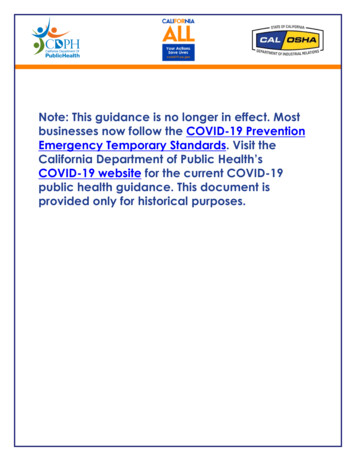
Transcription
Note: This guidance is no longer in effect. Mostbusinesses now follow the COVID-19 PreventionEmergency Temporary Standards. Visit theCalifornia Department of Public Health’sCOVID-19 website for the current COVID-19public health guidance. This document isprovided only for historical purposes.
COVID-19INDUSTRYGUIDANCE:Wineries and TastingRoomsNovember 24, 2020This guidance is designed to addresssectors and activities opening statewide.However, local health officers mayimplement more stringent rules tailoredto local epidemiological conditions, soemployers should also confirm relevantlocal opening policies.1
OVERVIEWOn March 19, 2020, the State Public Health Officer and Director of the CaliforniaDepartment of Public Health issued an order requiring most Californians to stay athome to disrupt the spread of COVID-19 among the population.The impact of COVID-19 on the health of Californians is not yet fully known. Reportedillness ranges from very mild (some people have no symptoms) to severe illness thatmay result in death. Certain groups, including people aged 65 or older and those withserious underlying medical conditions, such as heart or lung disease or diabetes, areat higher risk of hospitalization and serious complications. Transmission is most likelywhen people are in close contact or in a poorly ventilated area with an infectedperson, even if that person does not have any symptoms or has not yet developedsymptoms.Precise information about the number and rates of COVID-19 by industry oroccupational groups, including among critical infrastructure workers, is not availableat this time. There have been multiple outbreaks in a range of workplaces, indicatingthat workers are at risk of acquiring or transmitting COVID-19 infection. Examples ofthese workplaces include hospitals, long-term care facilities, prisons, food production,warehouses, meat processing plants, restaurants, and grocery stores.As stay-at-home orders are modified, it is essential that all possible steps be takento ensure the safety of workers and the public.Key prevention practices include: ensuring adequate ventilation in all spaces, physical distancing to the maximum extent possible, use of face coverings by workers (where respiratory protection is notrequired) and customers, frequent handwashing and regular cleaning and disinfection, training workers on these and other elements of the COVID-19 prevention plan.In addition, it will be critical to have in place appropriate processes to identify newcases of illness in workplaces and, when they are identified, to intervene quickly andwork with public health authorities to halt the spread of the virus.2
PURPOSEThis document provides guidance for wineries and tasting rooms that do not servemeals. Wineries that operate restaurants and serve bona fide meals (in accordancewith guidance issued by the California Department of Alcoholic Beverage Control,including guidance on what constitutes a meal) must follow the guidance forrestaurants. This guidance is to support a safe, clean environment for workers andcustomers. Businesses must identify and monitor the County Risk Level for the countythe business is operating in and make required adjustments to their operations: Purple – Widespread – Tier 1: Only outdoor operations are permitted, and Red – Substantial – Tier 2: Only outdoor operations are permitted, andoperators must follow the modifications in this guidance. Performers mustmaintain physical distancing from spectators and other performers. Performerswho are singing, shouting, playing a wind instrument, or engaging in similaractivities without a face covering must maintain at least twelve feet ofdistance from spectators. Additional modifications for performances may berequired by the forthcoming Live Performances guidance. Orange – Moderate – Tier 3: Indoor operations are permitted at 25% capacityor 100 people, whichever is fewer. Operators must follow the modifications inthis guidance. For indoor performances, performers must wear face coveringsand observe all other required modifications consistent with the forthcomingLive Performance guidance. In the interim, performers must wear facecoverings at all times and maintain physical distancing from spectators andother performers. Performers are counted toward the occupancy capacitylimit. Yellow – Minimal – Tier 4: Indoor operations are permitted at 50% capacity or200 people, whichever is fewer. Operators must follow the modifications in thisguidance. For indoor performances, performers must wear face coverings andobserve all other required modifications consistent with the forthcoming LivePerformance guidance. In the interim, performers must wear face coverings atall times and maintain physical distancing from spectators and otherperformers. Performers are counted toward the occupancy capacity limit.operators must follow the modifications in this guidance. Performers mustmaintain physical distancing from spectators and other performers. Performerswho are singing, shouting, playing a wind instrument, or engaging in similaractivities without a face covering must maintain at least twelve feet ofdistance from spectators. Additional modifications for performances may berequired by the forthcoming Live Performances guidance.For the most updated information on county tier status, visit Blueprint for a SaferEconomy. Please note that local health departments can have more restrictivecriteria and different closures. Find your county’s local information.NOTE: Wineries should refer to COVID-19 guidance from the California Departmentof Alcoholic Beverage Control. All guidance is subject to ABC license privileges for3
wineries. Wineries operating a “tasting room” only may sell their wine forconsumption on the premises. Wineries may also have a number of operationalaspects and service offerings available in other guidance on the Industry Guidanceto Reduce Risk website and on the California Department of Alcoholic BeverageControl website. Establishments may not open those operations until permitted bythe Blueprint and when doing so must review this guidance to apply the appropriateprotocols to all aspects of operations, including: Bona fide meal service in accordance with guidance provided by theCalifornia Department of Alcoholic Beverage Control (Restaurant guidance) Selling wine and brandy to be consumed off premises (Retail guidance andguidance from the California Department of Alcoholic Beverage Control) Wine production (Manufacturing guidance)This guidance is not intended for concert, performance, or entertainment venues.Those types of establishments should remain closed until they are allowed to resumemodified or full operation through a specific reopening order or guidance.The guidance is not intended to revoke or repeal any worker rights, either statutory,regulatory or collectively bargained, and is not exhaustive, as it does not includecounty health orders, nor is it a substitute for any existing or newly created safetyand health-related regulatory requirements such as those of Cal/OSHA, including apending Emergency Temporary Standard expected to go into effect soon.1 Staycurrent on changes to public health guidance and state/local orders as the COVID19 situation continues. Cal/OSHA has more comprehensive guidance on theirCal/OSHA General Guidelines on Protecting Workers from COVID-19 webpage. TheCDC has additional considerations for restaurants and bars.Required Use of Face CoveringsConsult the CDPH Guidance on the Use of Face Coverings, which broadly requiresthe use of face coverings for both members of the public and workers in all publicand workplace settings outside the home. Complete details, including allrequirements and exemptions to these rules, can be found in the guidance, whichshould be checked periodically for updates.For the most updated information on county status, visit Blueprint for a SaferEconomy. Please note that local health departments can have more restrictivecriteria and different closures. Find your county’s local information.4
Workplace Specific Plan Establish a written, workplace-specific COVID-19 prevention plan atevery location, perform a comprehensive risk assessment of all workareas and work tasks, and designate a person at each establishment toimplement the plan. Incorporate the CDPH Face Covering Guidance into the WorkplaceSpecific Plan and include a policy for handling exemptions. Identify contact information for the local health department where theoperation is located for communicating information about COVID-19outbreaks among workers or customers. Train and communicate with workers and worker representatives on theplan and make the plan available to workers and their representatives. Regularly evaluate the establishment for compliance with the plan anddocument and correct deficiencies identified. Investigate any COVID-19 illness and determine if any work-relatedfactors could have contributed to risk of infection. Update the plan asneeded to prevent further cases. Implement the necessary processes and protocols when a workplacehas an outbreak, in accordance with CDPH guidelines and orders orguidance from the local health department. Identify close contacts (within six feet for a cumulative total of 15 minutesor more over a 24-hour period) of an infected person and take steps toisolate COVID-19 positive worker(s) and close contacts. Notify all employees in writing, and employers of subcontractedemployees, who may have been exposed to COVID-19 and reportworkplace outbreaks to the local health department. For additionalinformation on employer responsibilities under AB 685 (Chapter 84,Statutes of 2020), refer to the Enhanced Enforcement and EmployerReporting Requirements from Cal/OSHA and the Employer Questionsabout AB 685 from CDPH. For outdoor operations: Establish an effective heat illness prevention planwith written procedures in both English and the language understood bythe majority of the employees. The plan must be available to employeesat the worksite. See the Cal/OSHA heat illness prevention page forresources, including FAQs, a webinar, and a sample written plan.Elements of a heat illness prevent plan must include:o Access to potable drinking water5
o Access to shadeo Cool down breakso Emergency procedures for heat illness caseso High heat procedures when the temperature exceeds 95 degreeso Monitoring of employees who are acclimatizing during a heat waveo Training on heat illness prevention and symptoms Adhere to the guidelines below. Failure to do so could result in workplaceillnesses that may cause operations to be temporarily closed or limited.Topics for Worker Training Information on COVID-19, how to prevent it from spreading, andwhich people are at higher risk for severe illness or death. Self-screening at home, including temperature and/or symptom checksusing CDC guidelines. The importance of not coming to work:o If a worker has symptoms of COVID-19 as described by the CDC,such as a fever or chills, cough, shortness of breath or difficultybreathing, fatigue, muscle or body aches, headache, new loss oftaste or smell, sore throat, congestion or runny nose, nausea,vomiting, or diarrhea, ORo If a worker was diagnosed with COVID-19 and has not yet beenreleased from isolation, ORo If, within the past 14 days, a worker has had contact with someonewho has been diagnosed with COVID-19 and is consideredpotentially infectious (i.e. still on isolation). To return to work after a worker receives a COVID-19 diagnosis only aftermeeting CDPH Guidance on Returning to Work or School FollowingCOVID-19 Diagnosis. To seek medical attention if their symptoms become severe, includingpersistent pain or pressure in the chest, confusion, or bluish lips or face.Updates and further details are available on CDC’s webpage. The importance of frequent handwashing with soap and water, includingscrubbing with soap for 20 seconds (or using hand sanitizer with at least60% ethanol (preferred) or 70% isopropanol (if the product is inaccessibleto unsupervised children) when workers cannot get to a sink or6
handwashing station, per CDC guidelines). Never use hand sanitizers withmethanol due to its high toxicity to both children and adults The importance of physical distancing, both at work and off work time(see Physical Distancing section below). Proper use of face coverings, including:o Face coverings provide some protection to the wearer but are notdesigned to meet standards for filtering virus-containing particles.o Face coverings do not replace the need for physical distancing andfrequent handwashing.o Face coverings must cover the nose and mouth.o Workers should wash or sanitize hands before and after using oradjusting face coverings.o Avoid touching eyes, nose, and mouth.o Face coverings must not be shared and should be washed ordiscarded after each shift. Information contained in the CDPH Face Covering Guidance, whichmandates the circumstances in which face coverings must be worn andthe exemptions, as well as any policies, work rules, and practices theemployer has adopted to ensure the use of face coverings. Trainingshould also include the employer’s policies on how people who areexempted from wearing a face covering will be handled. Ensure any independent contractors, temporary or contract workers,and volunteers at the facility are also properly trained in COVID-19prevention policies and have necessary supplies and PPE. Discuss theseresponsibilities ahead of time with organizations supplying temporaryand/or contract workers. Information on paid leave benefits the worker may be entitled to receivethat would make it financially easier to stay at home. See additionalinformation on government programs supporting sick leave and workers’compensation for COVID-19, including workers’ sick leave rights underthe Families First Coronavirus Response Act.7
Individual Control Measures and Screening Provide temperature and/or symptom screenings for all workers at thebeginning of their shift and any vendors, contractors, or other workersentering the establishment. Make sure the temperature/symptomscreener avoids close contact with workers to the extent possible. If requiring self-screening at home, which is an appropriate alternative toproviding it at the establishment, ensure that screening was performedprior to the worker leaving home for their shift and follows CDCguidelines, as described in the Topics for Worker Training section above. Encourage workers who are sick or exhibiting symptoms of COVID-19 tostay home. Employers must provide and ensure workers use all required protectiveequipment, including eye protection and gloves where necessary. Employers should consider where disposable glove use may be helpful tosupplement frequent handwashing or use of hand sanitizer; examplesare for workers who are screening others for symptoms or handlingcommonly touched items. Workers must wear gloves when handlingitems contaminated by body fluids. Workers moving items used by customers (i.e., dirty cups, plates, napkins,etc.) or handling trash bags must use disposable gloves (and wash handsbefore putting them on and after removing them) and aprons and thatare changed frequently. Dishwashers must use equipment to protect the eyes, nose, and mouthfrom contaminant splash using protective glasses, goggles, or a faceshield in addition to a face covering. Dishwashers must be providedimpermeable aprons and change them frequently. Reusable protectiveequipment, such as shields and glasses, should be properly disinfectedbetween uses. Employers must ensure workers maintain six feet of distance from otherswhenever possible. When it is not possible, the length and frequency ofinteraction should be kept to a minimum. Where job duties requireregular interaction (e.g. wait staff), employers should offer a secondarybarrier (i.e. face shields or safety goggles) for use by workers who wish touse one and permit workers to use their own if they prefer. Establishments must take reasonable measures, including public addressannouncements, posting signage in strategic and highly-visible locations,and in reservation confirmations, to remind the public that they must useface coverings whenever not eating or drinking (unless exempted perthe CDPH Face Covering Guidance), practice physical distancing, not8
touch their face, frequently wash their hands with soap and water for atleast 20 seconds, and use hand sanitizer. Remind customers in advance to bring a face covering, otherwise theyshould not be allowed to enter the premises (unless exempted per theCDPH Face Covering Guidance). Consider making face coveringsavailable for customers who may arrive without them. Customers should be screened for temperature and/or symptoms uponarrival, asked to use hand sanitizer, and to wear a face covering whennot eating or drinking. Employers have the right to cancel reservations forindividuals/parties with symptomatic customers and refuse entry. Display a set of clearly visible rules for customers and personnel atentrance(s) that are to be a condition of entry. The rules could includeinstructions to wear face coverings at all times when not eating ordrinking, use hand sanitizer, maintain physical distance from othercustomers, avoid unnecessary touching of surfaces, contact informationfor the local health department, and changes to services. Wheneverpossible, the rules should be available digitally, include pictograms, andincluded on/with menus.Ventilation, Cleaning, and DisinfectingProtocols Establishments should increase fresh air circulation by opening windowsor doors, if possible and in accordance with security and safety protocols. Position tables indoors near windows and doors to maximize airexchange and ventilation but avoid having air flow from where oneparty is seated directly toward another party. For indoor locations, maximize the amount of outdoor air supplied byventilation systems. Install the highest efficiency filters compatible withthe ventilation system. Where possible, install portable high-efficiency air cleaners, upgrade thebuilding’s air filters to the highest efficiency possible, and make othermodifications to increase the quantity of outside air and ventilation in allworking areas and other indoor spaces. Check the CDPH website periodically for updates on indoor air qualityand ventilation guidance for airborne diseases in indoor settings. Provide a clean glass for each tasting and, if possible, do not pourbeverages into a glass that a customer has already used (smelled, tastedfrom, etc.)9
Discontinue the use of communal dump buckets, spit buckets, spittoons,etc. Provide individual, disposable cups to each guest instead to avoidsplash contamination between customers. Do not touch beverage container necks to cups, glasses, etc., whenpouring wine, beer, or spirits. Perform thorough cleaning in high traffic areas, such as customer waitingareas and lobbies, break rooms, lunch areas, and areas of ingress andegress including host stands, entry ways, stairways, stairwells, escalators,handrails, and elevator controls. Frequently disinfect commonly usedsurfaces including doors, door handles, crash bars, light switches, waitingarea chairs, credit card terminals, ATM PIN pads, receipt trays, bus tubs,serving trays, phones, toilets, vehicle keys, and handwashing facilities. Frequently clean items touched by patrons, such as, productionequipment, barrels, decorative fountains, etc. Clean touchable surfacesbetween shifts or between users, whichever is more frequent, includingbut not limited to working surfaces, phones, registers,touchpads/touchscreens, tablets, time clocks, appliances, kitchen andbar utensils and implements, handles, carts and trolleys, keys, etc. Avoid sharing audio equipment, phones, tablets, laptops, desks, pens,and other work supplies wherever possible. Never share PPE. Discontinue shared use of audio headsets and other equipment betweenworkers unless the equipment can be properly disinfected after use.Consult equipment manufacturers to determine appropriate disinfectionsteps, particularly for soft, porous surfaces such as foam earmuffs. Provide time for workers to implement cleaning practices during theirshift. Assign cleaning assignments during working hours as part of theemployee’s job duties. Procure options for third-party cleaningcompanies to assist with the increased cleaning demand, as needed. Equip spaces such as tasting rooms, bar areas, host stands, and kitchenswith proper sanitation products, including hand sanitizer and sanitizingwipes for all staff directly assisting customers. Ensure that sanitary facilities stay operational and stocked at all timesand provide additional soap, paper towels, and hand sanitizer whenneeded. When choosing disinfecting chemicals, use products approved for useagainst COVID-19 on the Environmental Protection Agency (EPA)approved list and follow product instructions. Use disinfectants labeled tobe effective against emerging viral pathogens, diluted householdbleach solutions (5 tablespoons per gallon of water), or alcohol solutionswith at least 70% alcohol that are appropriate for the surface. Provide10
workers training on the chemical hazards, manufacturer’s directions,ventilation requirements, and Cal/OSHA requirements for safe use.Workers using cleaners or disinfectants must wear gloves and otherprotective equipment as required by the product instructions. Follow theasthma-safer cleaning methods recommended by the CaliforniaDepartment of Public Health and ensure proper ventilation. Continue to follow existing codes regarding requirements for sanitizing(rather than disinfecting) food contact surfaces. To minimize the risk of Legionnaires’ disease and other diseasesassociated with water, take steps to ensure that all water systems andfeatures are safe to use after a prolonged facility shutdown. Where possible, do not clean floors by sweeping or other methods thatcan disperse pathogens into the air unless all persons in the area haveappropriate PPE. Use a vacuum with a HEPA filter wherever possible. Provide disposable menus to customers and make menus availabledigitally so that customers can view on a personal electronic device, ifpossible. If disposable menus cannot be provided, properly disinfectmenus before and after customer use. Consider options for customers toorder ahead of time. Discontinue pre-setting tables with napkins, cutlery, glassware, etc. Theseshould be supplied individually to customers as needed. Do not leavecard stands, flyers, napkin holders, or other items on tables, counters, etc. Reusable customer items, such as glassware, must be properly washed,rinsed, and sanitized. Cleaned stemware, dishware, etc., must beproperly stored away from customers and personnel until ready for use.Use disposable items if proper cleaning of reusable items is infeasible. Dirty linens, such as tablecloths and napkins, should be removed aftereach customer use and transported from tasting areas in sealed bags.Workers should wear gloves when handling dirty linens. Thoroughly clean each customer drinking location after every use. Thiswill include disinfecting tables, chairs, etc., and allowing adequate timefor proper disinfection, following product instructions. EnvironmentalProtection Agency- approved disinfectants require a minimum contacttime (seconds to minutes) to be effective against human coronavirus. Close self-service areas where customers may congregate or touchitems that other customers may use, such as napkins, water pitchers, etc.Modify delivery of these items by providing items to customersindividually. Discard or clean, disinfect, or sanitize shared items aftereach use, as appropriate.11
Do not leave out mints, candies, or snacks for customers in self-servicereceptacles. Offer them with the check or provide only on request. Install hand sanitizer dispensers, touchless if possible, at guest and workerentrances and contact areas such as driveways, reception areas, intasting areas, near elevator landings, etc. Discontinue use of shared entertainment items that are difficult toproperly clean and disinfect.Physical Distancing Guidelines WARNING: physical distancing alone is insufficient to prevent transmissionof COVID-19. Prioritize outdoor seating to minimize cross flow of customers in enclosedenvironments. Wineries can expand their outdoor seating if they complywith local laws and regulations. Eliminate person-to-person contact for delivery of goods wheneverpossible. Designate drop-off locations to receive deliveries away fromhigh traffic areas. Maintain physical distance of at least six feet withdelivery drivers. Discontinue tours that combine individuals from different households intothe same tour group. Tour guides must maintain at least six feet ofphysical distance from customers/visitors. Wineries must use reservations and appointments when possible to allowfor time to disinfect tasting areas. Take measures to ensure that tasting group appointment times do notoverlap to minimize interaction of people from different groups andplaces. Consider allowing customers to order or make tasting reservations aheadof time to limit the amount of time spent in the establishment. Askcustomers to wait away from the establishment while waiting forappointments. Indoor and outdoor service tables must be at least six feet apart,measured from the back of the chair at one table to the back of thechair at the adjacent table while diners are seated. Maximize thedistance between indoor service tables beyond the required six feetwherever possible, to minimize the risks from customers drinking indoorswithout face coverings. Limit the number of patrons at a single table to a household unit orpatrons who have asked to be seated together. People in the same12
party seated at the same table do not have to be six feet apart. Allmembers of the party must be present before seating and hosts mustbring the entire party to the table at one time. Implement measures to ensure physical distancing of at least six feetbetween workers and customers/single groups. This can include use ofphysical partitions or visual cues (e.g., floor markings or signs to indicateto where workers and/or customers should stand). Install physical barriers or partitions at cash registers, bars, host stands,and other areas where maintaining physical distance of six feet isdifficult. Any area where customers or workers queue should also be clearlymarked for appropriate physical distancing. This includes check-standsand terminals, restrooms, elevator lobbies, host stands and waiting areas,valet drop off and pickup, and any other area where customerscongregate. Physical distancing protocols should be used in any office areas, kitchens,pantries, walk-in freezers, or other high-density, high-traffic work areas,where possible. Customers should enter through doors that are propped open orautomated, if possible. Hand sanitizer should be available for customerswho must touch door handles. Remove tables and chairs from tasting rooms and areas so that six feet ofphysical distance can be maintained for customers and workers. Iftables, chairs, booths, etc., cannot be moved, use visual/physical cues tomake them unavailable for use. Discontinue serving customers and/or groups at bar counters where theycannot maintain at least six feet of distance from work areas/stations. Discontinue open seating and standing areas. All members of acustomer group must be present before seating and hosts must bring theentire group to a designated tasting area at one time. Wheneverpossible, ask customers to be seated rather than standing to discourageunnecessary movement. Workers should take and deliver orders to customers to limit the numberof people moving around shared spaces. If customers must order fromthe bar, reconfigure space so that workers and customers can maintainat least six feet of distance from one another. Adjust music volume so that workers can maintain distance fromcustomers to hear orders and people can avoid speaking loudly orshouting.13
Implement peak period queueing procedures, including a host to remindcustomers to queue with at least six feet of distance between groupsoutside or in waiting areas. Limit the number of workers serving individual customers or groups, incompliance with wage and hour regulations. Encourage the use of credit cards and contactless payment systems. All workers should minimize the amount of time spent within six feet ofcustomers. Physical distancing protocols should be used in any office areas,pantries, walk-in freezers, or other high-density, high-traffic work areas,where possible. Worker pre-shift meetings and trainings should be conducted virtually orin areas that allow for appropriate physical distancing between workers.Food, beverages, food ware, etc., must not be shared. Stagger worker breaks, in compliance with wage and hour regulations,to maintain physical distancing protocols. Consider offering workers who request modified duties options thatminimize their contact with customers and other workers (e.g., managinginventory rather than working as a cashier or managing administrativeneeds through telework. Reconfigure office spaces, lobbies, beverage bars, workstations, hoststand areas, and other spaces wherever possible to allow for at least sixfeet of distance between people drinking or tasting, working, andpassing through areas for entry and exit. Ensure workers can maintain physical distance in breakrooms, usingbarriers, increasing distance between tables/chairs to separate workers,etc. Where possible, create outdoor break areas with shade coveringsand seating arrangements that ensures physical distancing. Discourageworkers from congregating during breaks and ensure they are not eatingor drinking without face coverings within six feet of each other. Do not allow people to congregate in high traffic areas
wineries. Wineries operating a “tasting room” only may sell their wine for consumption on the premises. Wineries may also have a number of operational aspects and service offerings available in other guidance on the Industry Guidance to Reduce Risk website and on the Cal


